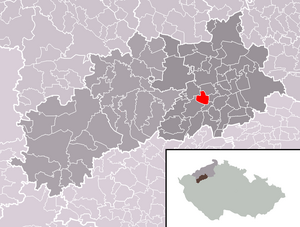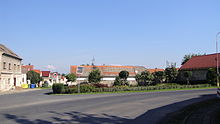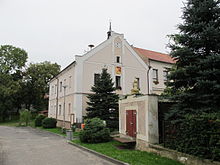Líšťany u Cítolib
| Líšťany | ||||
|---|---|---|---|---|
|
||||
| Basic data | ||||
| State : |
|
|||
| Region : | Ústecký kraj | |||
| District : | Louny | |||
| Area : | 602.8851 ha | |||
| Geographic location : | 50 ° 19 ' N , 13 ° 48' E | |||
| Height: | 299 m nm | |||
| Residents : | 447 (Jan. 1, 2019) | |||
| Postal code : | 440 01 | |||
| License plate : | U | |||
| traffic | ||||
| Street: | Louny - Rakovník | |||
| structure | ||||
| Status: | local community | |||
| Districts: | 1 | |||
| administration | ||||
| Mayor : | Miroslav Protiva (as of 2013) | |||
| Address: | U Svatého Jána 100 440 01 Líšťany |
|||
| Municipality number: | 546879 | |||
| Website : | www.obec-listany.cz | |||
| Location of Líšťany in the Louny district | ||||

|
||||
Líšťany , until 1923 Lišťany (German Lishtian ) is a municipality in the Czech Republic . It is located five kilometers south of Louny and belongs to the Okres Louny .
geography
Líšťany is on the Dolnooharská tabule ( Untereger table ). The Draha (355 m) rises to the southwest and the Zadní Háj (291 m) to the northwest. State road II / 229 between Louny and Rakovník runs through the village .
Neighboring towns are Louny and Cítoliby in the north, Blšany u Loun , Chlumčany and Vlčí in the northeast, Brloh , Smolnický Mlýn and Smolnice in the east, Hříškov and Nová Ves in the southeast, Divice, Brodec , Brodecký Mlýn and Břínwkov in the south, Senkovín and Zbraínkov in the south , Touchovice, Opočno , Jimlín and Nový Hrad in the west and Zeměchy and Březno in the northwest.
history
Líšťany was probably founded in the 12th or 13th century. The place name is derived from the old Czech Léščěné and denotes a place with hazel bushes. The first written mention of the village came on July 13, 1346 when Henricus Sleyda de Lezczan appeared as a witness in a document about Pochvalov .
It is assumed that Henricus Sleyda came to Bohemia as a follower of King John of Luxembourg and was enfeoffed by him with the royal estate of Lezczany ; possibly he came from the family of the Lords of Schleiden . His seat was probably east of the village in the Na hrádku corridor . Henricus Sleyda de Lezczan can be traced back to 1362, after which the royal court master Albert the Elder acquired Ä. from Kolowrat most of Lezczany . This transferred his share of the village in 1380 to the Augustinian monastery Dolní Ročov , founded by him in 1373 . After the monastery was destroyed by the Hussites in 1424, the Líšťany estate returned to the possession of the lords of Kolowrat. These sold Horní Ročov and part of Líšťany in 1523 together with the Pravda Castle to Diepolt von Lobkowicz . The owners of the other part were from 1553 the Selmický knights of Cítov. Adam Hruška von Březno acquired this part in 1573 together with the Selmice manor and gave it to his dominion in Cítoliby. After the Dolní Ročov Monastery was economically stabilized again around 1600, its goods were transferred back. In the first quarter of the 17th century Líšťany consisted of 46 farms, 34 of which belonged to the Augustinian convent Dolní Ročov, eleven to the Cítoliby rule and one to the Postelberg rule . At that time Líšťany had 230 inhabitants and was one of the largest villages around Louny.
Because of its location on the road from Rakovník to Louny, the village was occupied and plundered several times by troops passing through during the Thirty Years' War. Electoral Saxon troops invaded in 1631 and the Swedes in 1634, 1639/1640, 1643 and from 1645 to 1648. In 1651 only 47 people lived in Líšťany. In the Berní rula from 1654, 27 of the 46 farmsteads are listed as desolate . It was not until the middle of the 18th century that the village was completely restored and settled. During this time, small hop gardens were also created for the residents' own needs. The Augustinians had the Meierhof rebuilt and the house chapel laid out. The goods Líšťany and Ročov, separated by the rule of Cítoliby and the estate of Toužetín , were merged by the Augustinian Convent to form one estate with its seat in Líšťany. When house numbering was introduced in 1787, Líšťany consisted of 63 houses, 46 of which belonged to Ročover and 17 to Cítoliber. In 1828 451 people lived in the 84 houses of Líšťany. Between 1841 and 1843 the new road from Rakovník to Louny was built.
In 1844 the Lishtian estate, which belonged to the Augustinian convent Unter-Rotschow, had a usable area of 1463 yoke 186 square fathoms. 961 Czech-speaking people lived on its territory, including two Jewish families. Grain and hops were the main source of income. The authorities managed two farms with sheep farms in Lishtian and Rotschow . The manorial forests were located exclusively in the southern part and comprised the 55 yoke 1076 square fathoms large Rotschower Wald and the 43 yoke 294 square fathoms large pine forest Bor between Aulowitz, Solopisk ( Solopysky ) and Kozoged .
Good for Lischtian included the villages Lischtian, sub-Rotschow and Aulowitz ( Úlovice ).
The village Lishtian , also Leschzan / Lissťan or Lessťan consisted of a total of 89 houses with 551 inhabitants, including a Jewish family on the Rotschow part. 75 houses belonged to the Rotschower part and 14 to the Zitoliber part. On the Rotschower part there was an official castle with a house chapel to the hll. Johannes and Paulus as well as the administrator's apartment, a magistrate's farm, a Dominical sheep farm and an inn. Another inn was located on the Zitoliber part. The parish was Zitolib. Until the middle of the 19th century Lishtian was the official village of the property of the same name.
After the abolition of patrimonial , both shares were combined from 1850 to form the municipality of Léšťany / Lishtian in the Rakonitz district and Laun district . From 1868 the village belonged to the Laun district . In 1869 Léšťany was replaced by Cítoliby as the most populous place in the district after the city of Laun. The following year a one-class village school began teaching. This was increased until 1875 for two-class teaching. At this time, the Horymír coal mining association made some unsuccessful attempts to find the Kaunowa-Schlaner seam ( kounovsko-slánská sloj ), but it soon disbanded. The volunteer fire brigade was founded in 1879. In 1896 school lessons began in three classes. At the end of the 19th century the village was known as Lešťany and since the beginning of the 20th century as Lišťany . In the 1921 census, 1,019 people lived in the village's 191 houses. The current form of the name Líšťany has been in use since 1924. In the same year it was connected to the electricity network. After the Munich Agreement , Líšťany became a border town with the German Empire. In 1940 a swimming pool was opened in the Líský corridor on Rakonitzer Strasse at the southwest exit of the town. In 1974 a house of culture was built, which today is again owned by the municipality. On January 1, 1981, it was incorporated into Louny. At the beginning of 1992 Líšťany broke away from Louny and formed its own community. The community has had a coat of arms and a banner since 1998.
Community structure
No districts are shown for the municipality of Líšťany.
Attractions
- Baroque Líšťany farmstead (No. 1) from the early 18th century, at the northern exit of the village. The house chapel of hll, which was restored in 2012, belongs to the courtyard, which is also known as the castle . John and Paul
- Memorial to the 27 fallen in World War I, unveiled in 1922
- Monument to the fallen Czechoslovak legionaries , created in 1999
- Cross with a relief of the Sorrowful Virgin Mary, created in the 18th century, on the eastern outskirts
- Niche chapel on the way to Zeměchy, built in the 18th century
- Niche chapel in the fields northwest of Líšťany, it was built at the beginning of the 19th century
Personalities
Sons and daughters of the church
- Miroslav Štumpf (1917–1988), theologian and professor at the University of Rome
- Zdeněk Kovanda (1922–1999), Czechoslovak cyclist and trainer
- Josef Šedivý (1925–2008), Czechoslovak naturalist and author of scientific publications on pest control using hymenoptera
Líšťany lived and worked
- Jan Ryska (1916–1983), the writer and screenwriter, came to Líšťany with his parents at the age of eight and grew up there.
- Vladislav Mirvald (1921–2003), the painter lived for a while in Líšťany
Individual evidence
- ↑ http://www.uir.cz/obec/546879/Listany
- ↑ Český statistický úřad - The population of the Czech municipalities as of January 1, 2019 (PDF; 7.4 MiB)
- ↑ Johann Gottfried Sommer The Kingdom of Bohemia, Vol. 14 Saatzer Kreis, 1846, pp. 46–47
- ↑ a b Johann Gottfried Sommer The Kingdom of Bohemia, vol. 14 Saatzer Kreis, 1846, p. 45
- ↑ Johann Gottfried Sommer The Kingdom of Bohemia, Vol. 14 Saatzer Kreis, 1846, p. 47
Web links






